|
Getting your Trinity Audio player ready...
|
With its towering peak and untamed wilderness, Mount Rainier National Park is a beacon of adventure for those seeking an escape from city life. The rugged landscape boasts stunning vistas, diverse wildlife, and cozy lodges steeped in history, drawing in intrepid travelers from bustling Seattle and beyond.
Established in 1899
Nestled in the lush forests of Washington state lies Mount Rainier National Park, a true gem of the American wilderness. Established in 1899, it boasts over 236,000 acres of diverse landscapes, from the towering peak of Mount Rainier to its expansive valleys, glistening waterfalls, and untouched subalpine meadows. As the highest point in the Cascade Range, this stratovolcano offers unparalleled opportunities for adventure and exploration.
Brave adventurers can trek through 91,000 acres of old-growth forest, marvel at more than 25 glaciers descending its slopes, and bask in its surreal beauty as they navigate through ever-changing cloud cover and abundant rain and snow. Discover an unforgettable experience at Mount Rainier National Park – where nature reigns supreme and adventure awaits at every turn.
The majestic Mount Rainier looms over a picturesque landscape, its snow-capped peak glistening in the sun. The Wonderland Trail winds around its base, leading brave adventurers through 35 square miles of awe-inspiring glaciers and snowfields.
Among them, the massive Carbon Glacier reigns supreme as the largest by volume in all of the contiguous United States. But for those seeking an even greater challenge, the expansive Emmons Glacier presents itself as the largest by area. With over 10,000 annual attempts and a success rate of only 50%, conquering this iconic peak is no easy feat. But for thrill-seekers and nature lovers alike, it is an irresistible call to adventure.
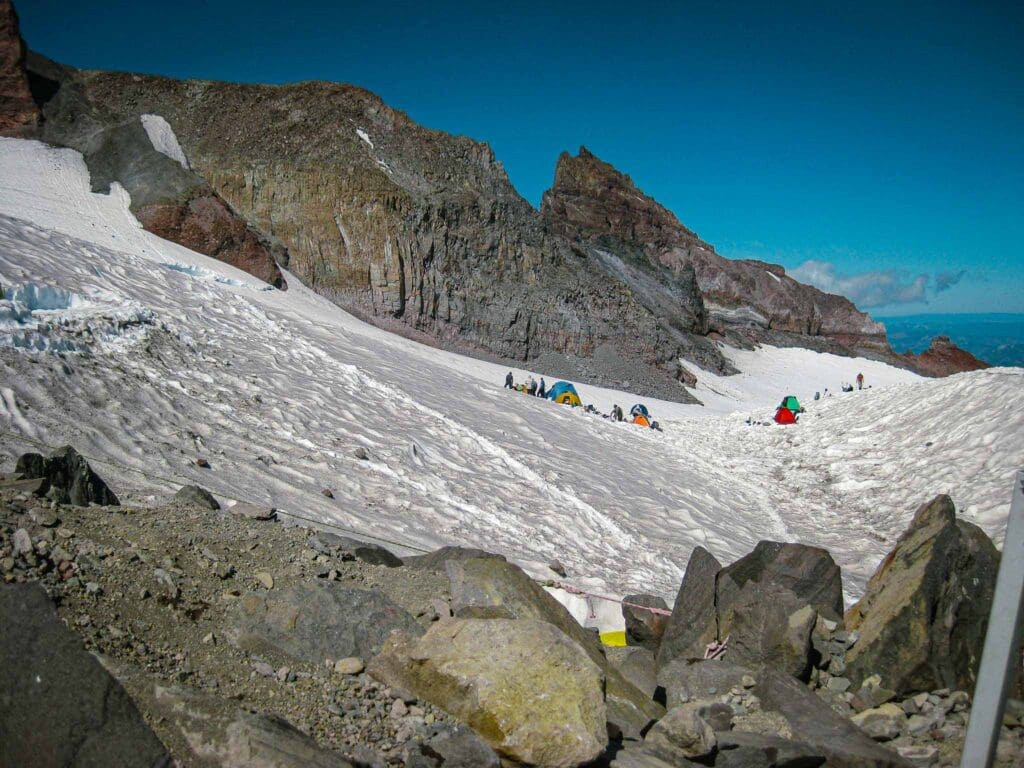
Camp Muir in Mount Rainier National Park.
Deep within the embrace of Mount Rainier awaits Paradise – a fitting name for the picturesque trails that wind through fields of dazzling wildflower blooms. As you trek, your senses are treated to sweeping vistas of Unicorn Peak and its majestic mountain companions to the south. And as you journey along the winding road from the Nisqually Entrance, wondrous waterfalls and breathtaking peaks reveal themselves at every turn, offering an exhilarating communion with Mother Nature herself.
While hiking is easily the best way to experience the region, Mount Rainier National Park has numerous sights to see that don’t require much hiking. The park was established as a National Historic Landmark District because of how well the original architecture at the base camps has been preserved. Each year, hundreds of thousands of tourists visit the three main base camps for impeccable views of the mountain as well as the rest of the park.
Paradise sits at 5,400 feet and is the starting point for the main route up Mount Rainier. Longmire sits at a lower elevation and is the second most visited section of the park. Lower elevations allow for Longmire to be open throughout the year. Lastly, Sunrise sits at the northeastern section of the park. At 6,400 feet it is the highest point in the park that is accessible by car. True to its name, Sunrise is known for impeccable sunrise views of the mountain and its surrounding forests and meadows.
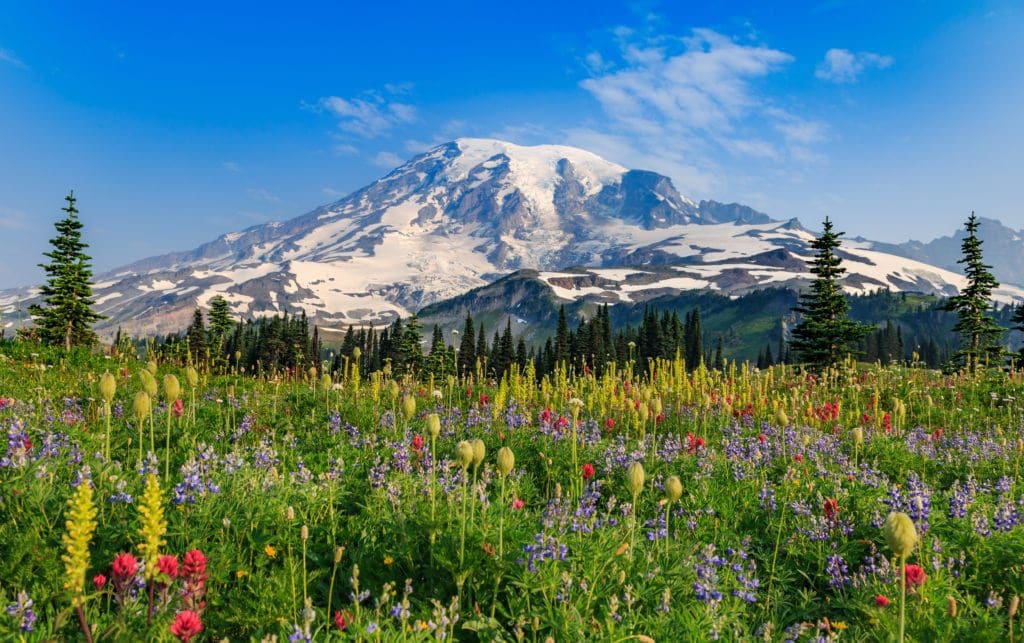
Views of Mount Rainier at Paradise in full bloom.
Luxury Campervan Rentals for Iconic Road Trips: Moterra Campervans is your gateway to exploring America’s most beautiful landscapes with complete comfort and capability. Rent a luxury Mercedes Sprinter van fully loaded for road trips and vacations, with curated itineraries for national parks and other breathtaking public lands. Rental Hub located in Seattle, Washington.
Book Now!
History
Long before the region was established as a National Park, the land was home to Native Americans dating back to 4,000-5,800 BC. The Columbia Plateau Tribes inhabited the region from around 1000 to 300 BC. Prior to becoming a national park, the surrounding land was designated as a national forest. However, in 1899 then President William McKinley passed a bill that established Mount Rainier National Park. The park was the fifth national park in the entire nation.
In 1888 John Muir visited the park with a few other explorers. This trip is often attributed to his reinvigoration for conservation. His work helped transform the once national forest into the national park that it now is today. Finally, on the sixth attempt at pushing the bill, it passed and the park was established just before the turn of the century. Today the camp that sits at about 10,000 feet is named Camp Muir after John Muir and his work for helping establish the park.
Mount Rainier National Park is enjoyed throughout the year by locals and visitors alike, though most popular during the summer months. However, the park had to be closed in late 2006 when extreme flooding took place. The park received over 18 inches of rainfall in just a 36-hour period. Severe damage was caused to many riverfront campsites while some roads were completely washed out. The park reopened in the late spring of 2007 to allow tourist access.
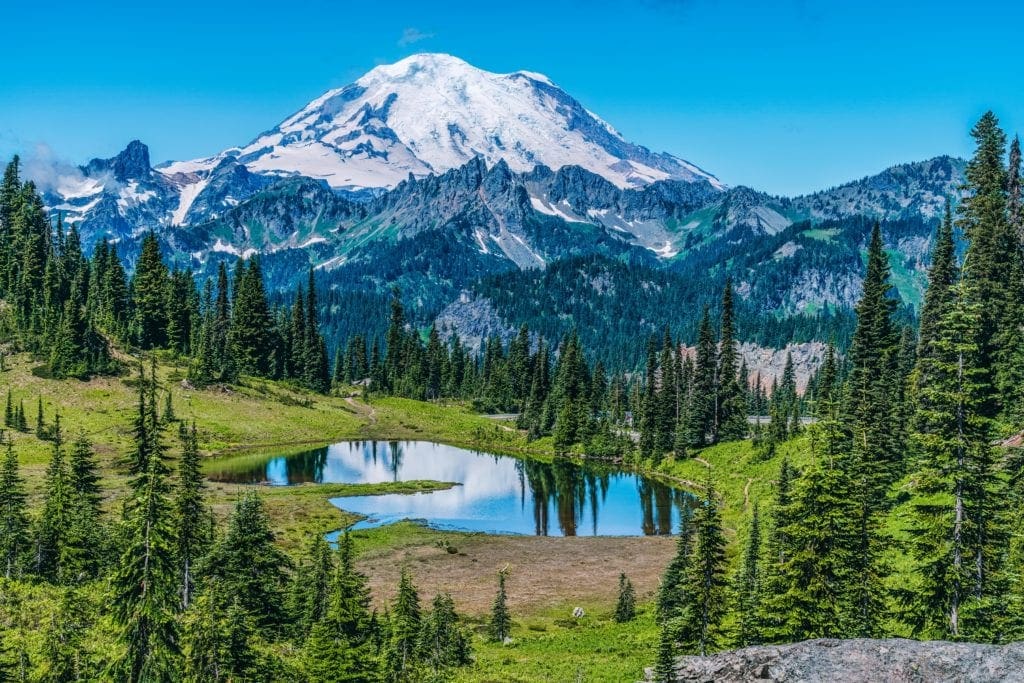
Alpine reflections on Tipsoo Lake at Mount Rainier National Park, Washington.
Geology, Flora, Fauna
Standing at 14,411 feet, Mount Rainier is the tallest point in the Cascade Range. There are over 25 glaciers surrounding the mountain, feeding some of the major rivers and streams of the region. The Carbon Glacier sits on the northern slope of the mountain and is the largest glacier by volume in the contiguous United States. On the northeastern flank of the mountain is Emmons Glacier. This massive glacier is known for being the largest by area in the contiguous United States. The glaciers alone on the mountain draw thousands of mountain climbers each year.
Mount Rainier is an active volcano and scientists often discuss how it is past due for a massive explosion. Because of this, Mount Rainier is known as being one of the most dangerous volcanoes in the world. However, the peak is heavily observed. If and when the mountain erupts, the entire population of the Puyallup River valley would be at risk, which includes nearly 100,000 people. Experts estimate that Mount Rainier was once 16,000 feet tall but has eroded heavily over the past 5,000 years. Past lahars have traveled all the way to the Puget Sound to what is now Tacoma and Seattle. Though a massive explosion is unlikely in the very near future, the active volcano does cause about one earthquake per week that can be detected near the summit.
Mount Rainier National Park is known for more than just it’s impressive volcano. The park is home to some of the best displays of wildflowers in the entire world. There are over 1,000 species of plants and fungi found throughout the park. Popular wildflowers include lilies, asters, daisies, paintbrush, fireweed and numerous others. The best time to view these fields is from late July to early August.
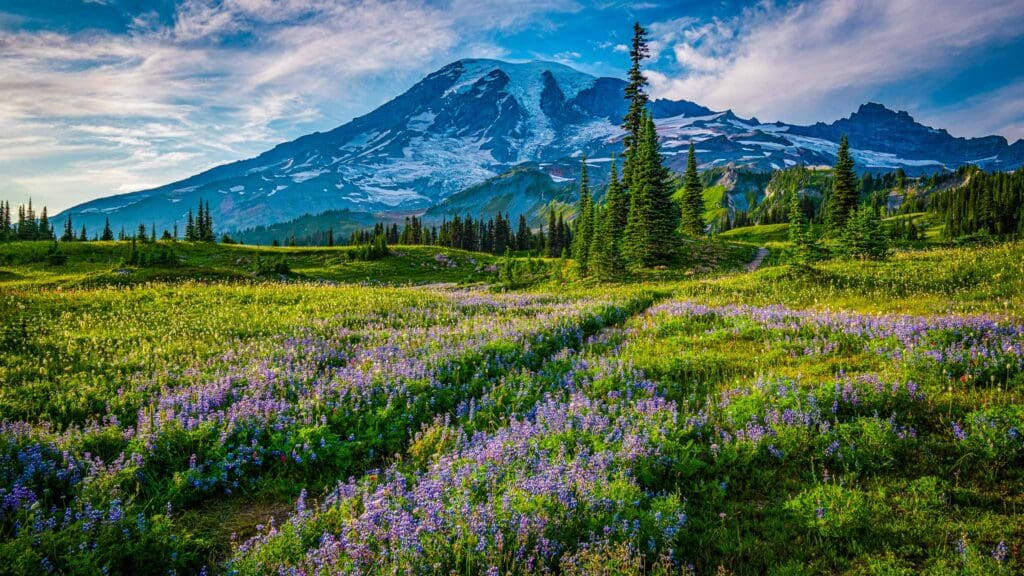
Views of Mount Rainier at Paradise, Washington.
Other sections of the park are dominated by over 90,000 acres of old growth forest. Here the forest is estimated to be over 1,000 years old, and is intermixed with younger sections of forest. Most of these forested sections are made up of Douglas fir, western red-cedar, and the western hemlock. Higher elevation forests are full of western white pine, noble fir, and the Pacific silver fir.
Besides a range of diverse ecosystems and plant life, the park is also home to a variety of wildlife. On land, Mount Rainier National Park is home to over sixty types of mammals. Some of the most notable include elk, marmots, mountain goats, cougar, Cascade red fox, and black bear. The black bears in the park are often quite used to seeing humans though hikers should still express extreme caution when encountering one. The endangered Northern Spotted Owl lives within the park, helping protect it as its population tries to regrow. The waters of the park are home to various salmon and trout species. In the mid-1900s many of the lakes were stocked with fish though that ended back in 1972. Despite no longer being stocked, nearly 30 of the lakes in the park are home to fish populations.
Looking For An Amazing Adventure? Book A Guided Hiking Tour in the Washington Wilderness.
Best Places To Stay
For those who appreciate the beauty of nature, Mount Rainier National Park is a must-visit destination. Luckily, there are multiple options for accommodation both within and near the park. Here are some of the top places to stay while exploring Mount Rainier National Park in Washington.
- For those who wish to remain within the park, there are two options for lodging: the Paradise Inn and the National Park Inn. Each lodge offers cozy accommodations, dining options, and breathtaking vistas of the mountain. The Paradise Inn is available from mid-May to early October, while the National Park Inn welcomes guests year-round. Reservations can be made online for either lodge.
- For those who enjoy camping, there are four campgrounds available in the park: Cougar Rock, Ohanapecosh, White River, and Mowich Lake. Each campground offers restrooms, fire rings, and picnic tables; however, only Cougar Rock and Ohanapecosh have drinkable water. Reservations for campsites at Cougar Rock and Ohanapecosh can be made online, but White River and Mowich Lake operate on a first-come, first-served basis.
- For those who prefer to stay outside of the park, there are numerous options for accommodations in the nearby towns of Packwood, Ashford, Crystal Mountain, and Greenwater. These towns are located near park entrances and provide a diverse range of amenities and activities. A few highly recommended hotels in these towns include LOGE Alta Crystal, Suncadia Resort, and Crystal Mountain Hotels.
Major Attractions
On February 18, 1997, the entire park received its official title as a National Historic Landmark District in recognition of its amazing preservation and beautifully crafted rustic-style architecture by the National Park Service. Within the park’s boundaries, there are 42 specific areas that have been added to the National Register of Historic Places, with four of them receiving additional recognition as National Historic Landmarks. In every corner throughout the vastness of Mount Rainier National Park, visitors can experience their own unique delights.
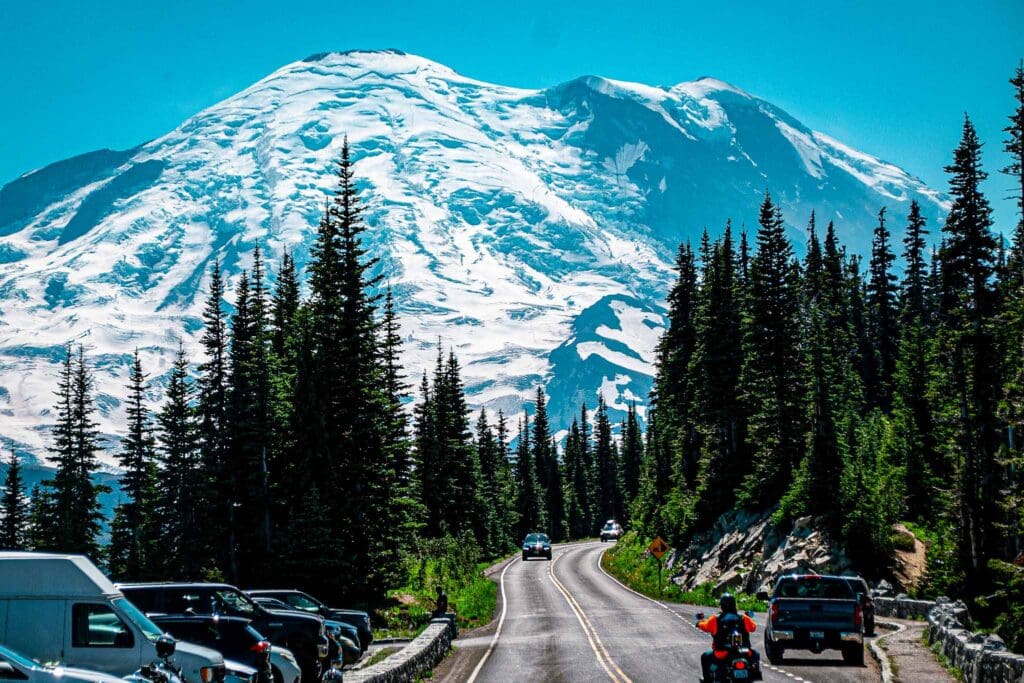
Road to Sunrise
Paradise (located at 46.79°N 121.74°W): is an area situated at an elevation of approximately 5,400 feet (1,600 m) on the south slope of Mount Rainier within the national park. It is the most frequented destination for tourists visiting Mount Rainier National Park, with a staggering 62% of the over 1.3 million visitors in 2000 making their way to this picturesque spot. Paradise is nestled near the subalpine valley of the Paradise River and is home to notable structures such as the historic Paradise Inn, constructed in 1916; Paradise Guide House, built in 1920; and Henry M. Jackson Visitor Center, originally erected in 1966 but reconstructed in 2008.
Paradise boasts stunning vistas and vibrant fields of wildflowers. As Martha Longmire first set her eyes on this breathtaking landscape, she could only exclaim, “Oh, what a paradise!” The main visitor center, named in honor of Henry M. Jackson, sits atop the upper parking area.
In the winter, when an average of 640 inches (53.6 feet/16.2 meters) of snow blankets the area, Paradise becomes a haven for adventurers seeking to snowshoe, cross-country ski, or sled through the picturesque wonderland. Although the road between Longmire and Paradise is plowed, it closes at night during this season – but don’t let that deter you from experiencing this winter paradise! Make your way 19 miles (30 km) east from the Nisqually Entrance or 12 miles (19 km) east from Longmire to reach this enchanting destination.
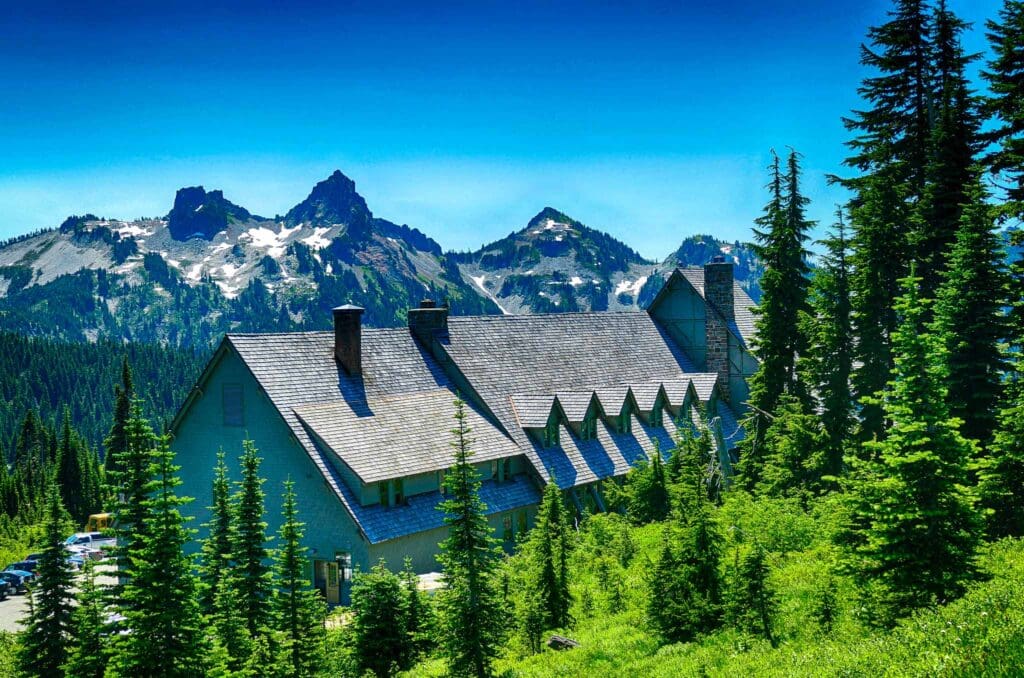
Paradise Inn with Tatoosh range in background, Mount Rainier National Park, Washington
Interesting fact: The Paradise region was once home to the world’s highest recorded amount of snowfall in a single year, reaching 93.5 feet (28.5 meters) during the winter of 1971-1972.
Longmire (located at 46.75°N 121.81°W): Longmire is a visitor center within Mount Rainier National Park, situated about 6.5 miles (10.5 km) to the east of the Nisqually Entrance. It was named after James Longmire, one of the first settlers in the Puget Sound region. The area, surrounded by old-growth trees like Douglas fir and western red cedar, sits between The Ramparts Ridge and Tatoosh Range at an elevation of 2,761 feet (842 m).
In Longmire, visitors can find the National Park Inn, the Longmire Museum, and the former 1928 National Park Service Administration Building, now serving as a Wilderness Information Center. The National Park Inn is the only year-round accommodation available within the park. It’s also the second most popular destination for visitors after Paradise; according to 2000 data, 38% of the more than 1.3 million people who visited the park made their way to Longmire.
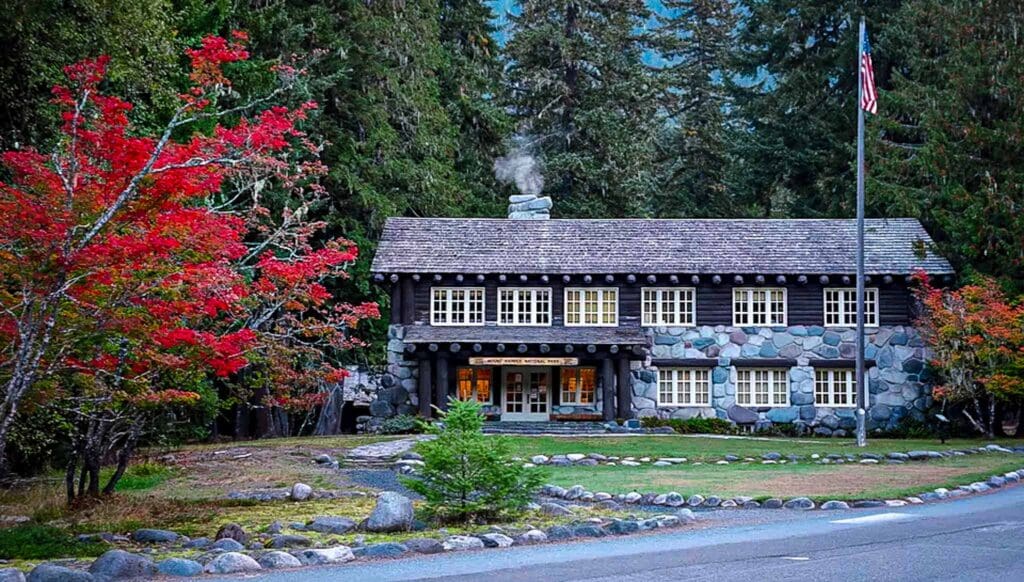
Located in the National Historic Landmark District at Longmire, the Administration Building serves as the seasonal home for the Longmire Wilderness Information Center. Photo: NPS
For outdoor enthusiasts looking to explore more of the park, Cougar Rock Campground is located approximately 2 miles (3.2 km) northwest of Longmire and offers 173 individual campsites and 5 group sites from late May until late September. Lastly, Longmire is a starting point for those embarking on the renowned Wonderland Trail adventure.
Sunrise (located at 46.91°N 121.64°W): Situated in the northeastern area of the park, Sunrise is a popular lodge and visitor center. It holds the title of being the highest point in the park that can be reached by vehicle, with an elevation of 6,400 feet (1,950 m).
During the summer season, the meadows are filled with colorful wildflow ers. Surrounding the lodge are numerous hiking trails, including Mount Fremont, Burroughs Mountain, and Sourdough Ridge. On clear days, visitors can enjoy awe-inspiring views of Mount Rainier and Emmons Glacier from Sunrise. At Sunrise Point, one can take in panoramic vistas of the surrounding valleys, other Cascade Range volcanoes such as Mount Adams, and of course, majestic Mount Rainier. With its stunning scenery and well-maintained trails, it’s no wonder that Sunrise is the park’s second most popular destination.
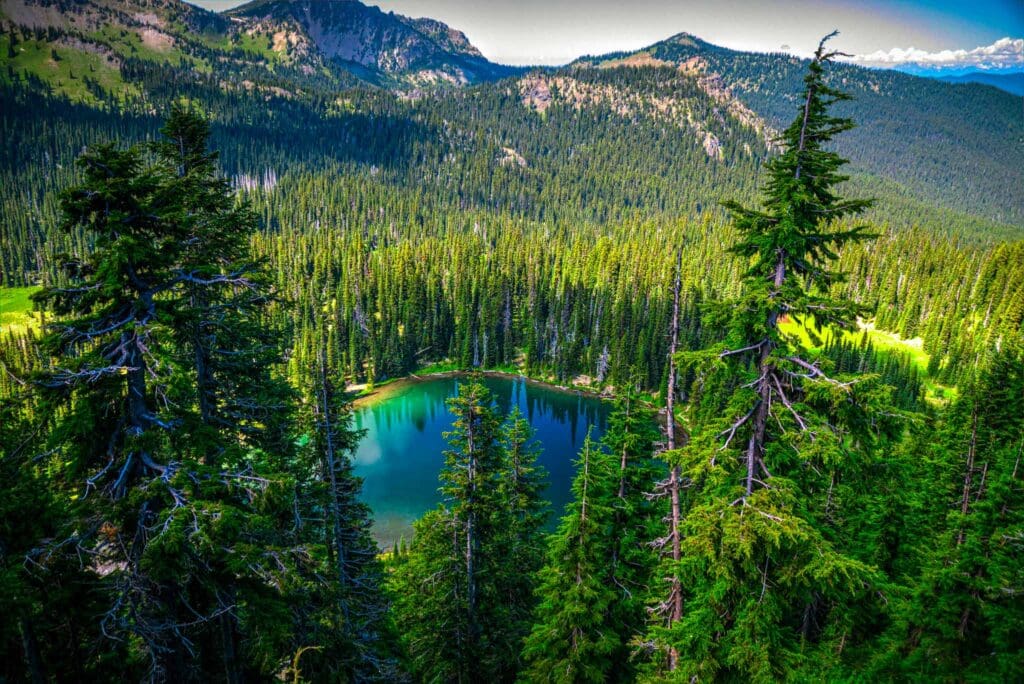
Sunrise Lake from Sunrise Point in Mt Rainier National Park
To reach Sunrise, one must travel 60 miles northeast from the Nisqually Entrance. The easiest way to access this location is through a 10-mile (16 km) turnoff from State Route 410 near the White River entrance.
Ohanapecosh: Nestled in the southeast corner of the park, Ohanapecosh gets its name from a Taidnapam Indian settlement along the river, meaning “standing at the edge.” Surrounded by lush Douglas-firs, western red cedars, and western hemlocks, Ohanapecosh offers visitors the chance to explore an old-growth forest and all its intricate beauty. The east side of the park is typically drier and sunnier compared to the west side, making it a great option for those seeking refuge from wet and foggy conditions in Paradise and Longmire.
The Ohanapecosh campground offers 188 individual sites and 2 group sites, open from late May to late September. Along with a visitor center and ranger station, this is the only developed section of the park without a Mount Rainier view. Surrounded by towering trees and located at an elevation below 2,000 feet, it serves as a tranquil escape for visitors. Nearby attractions include the beloved Ohanapecosh Hot Springs, Grove of the Patriarchs, and Silver Falls.
However, Ohanapecosh is not accessible during the winter months. You can find Ohanapecosh 3 miles (4.8 km) north of the park boundary on State Route 123, and about 42 miles (68 km) east of the Nisqually Entrance.
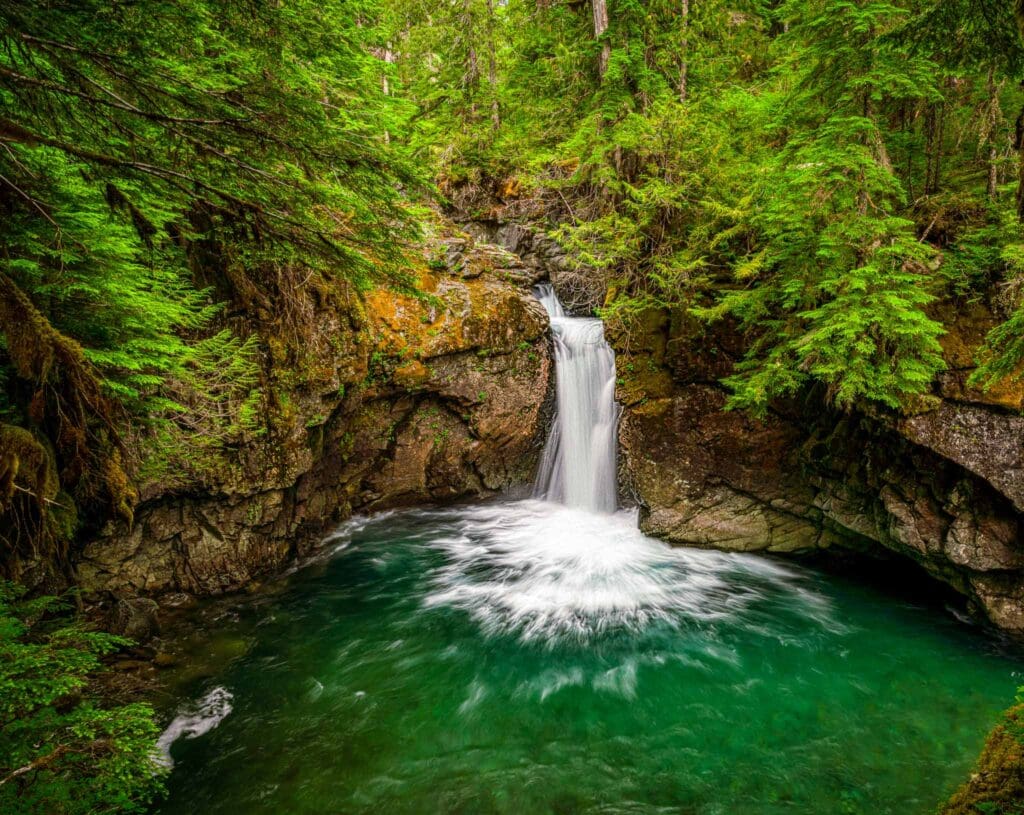
Stafford Falls drops 30 feet into a clear plunge pool. To reach it, follow the Owyhigh Lakes Trail 0.4 miles from Highway 123 to the Eastside Trail, then about 1.4 miles south on the Eastside Trail. A short spur trail leads to a viewpoint.
NOTE: The Grove of the Patriarchs is CLOSED to all public entry until further notice, due to flooding which caused significant damage to the suspension bridge that provides the only safe access to the area (News Release, 11/17/21).
Carbon River Entrance Station: In the northwest section of the park, off State Route 165, lies the Carbon River Entrance Station. This is the only location within Mount Rainier where a rainforest can be found. Visitors can explore a short trail through this unique ecosystem, as well as a path to the Carbon Glacier, which is one of the lowest glaciers in the contiguous United States.
Located south of Carbon along State Route 165 is Mowich Lake, the largest and deepest lake in the park. A variety of recreational activities can be enjoyed here, including camping, picnicking, and hiking. The major roads leading into this area were heavily damaged by floods in 2006. During the summer season, rangers are stationed at the Carbon River entrance station to assist visitors. Beyond this point, motor vehicles are not allowed.
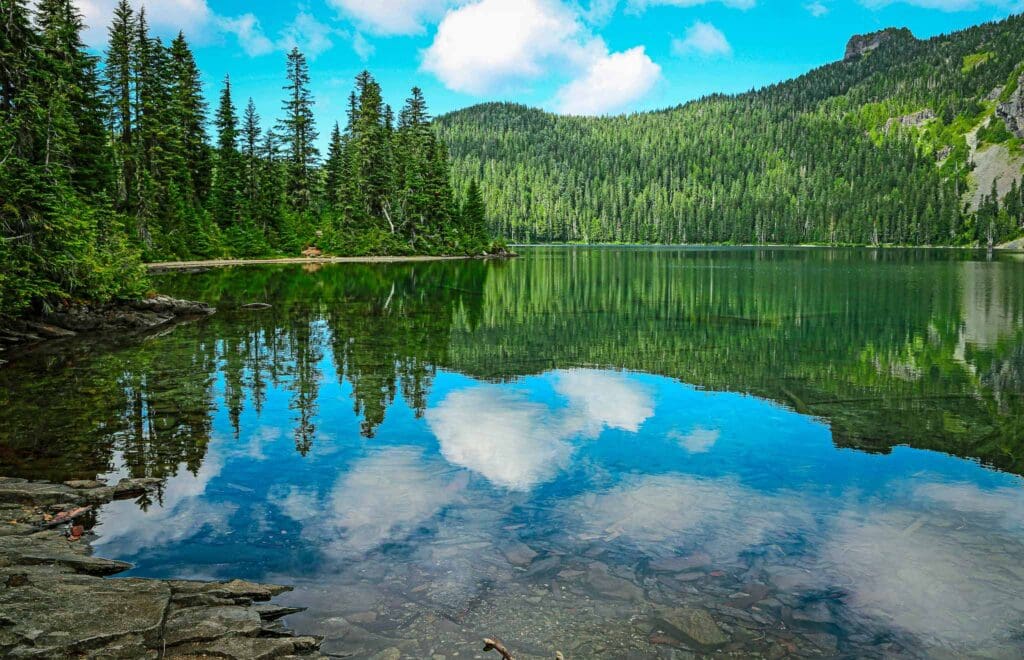
Mowich Lake
Activities
The great outdoors beckons with endless possibilities for all types of adventurers. Take a leisurely stroll or challenge yourself with a steep climb – the choice is yours.
Timed Entry Requirements:
Mount Rainier National Park has experienced an approximate 40% increase in visitation over the last 10 years, leading to overcrowding during the summer and damage to fragile ecosystems. In 2024, Mount Rainier National Park will implement a pilot timed entry reservation system to improve the visitor experience to the park by reducing wait times, congestion, and resource impacts on trails caused by overcrowding.
A timed entry reservation is required for two areas of the park: (1) Paradise Corridor coming from the southwest (near Ashford, WA) or southeast (near Packwood, WA), and (2) Sunrise Corridor coming from the northeast (via Enumclaw, WA) from 7:00 am to 3:00 pm. Each corridor requires a separate vehicle reservation. Timed entry reservations are for good a single day, per vehicle, and are required in addition to an entrance fee or park pass.
- May 24 through September 2 timed entry reservations are required to enter the Paradise Corridor on the south side of the park from 7:00 am to 3:00 pm.
- July 3 through September 2 timed entry reservations are required to enter the Sunrise Corridor on the northeast side of the park from 7:00 am to 3:00 pm.
- Visitors entering the park in a vehicle or on a motorcycle in one of these areas during these dates need two things:
- A timed entry reservation OR service reservation (lodging, camping, wilderness permit, etc.), AND
- Park Entrance Fee OR valid Park Pass (Annual, Senior, Military, etc.). See the NPS FAQ page for details.
- The park is open 24/7 and visitors may enter timed entry reservation areas before 7:00 am or after 3:00 pm without a reservation. Learn more about visiting without a reservation.
Hiking:
By far the most popular activity in the park is hiking. The expansive park offers a vast network of trails totaling 260 miles. There are plenty of options for hikers, ranging from leisurely walks to challenging climbs, making it a suitable activity for all levels.
A highly recommended route is the Skyline Trail leading to Panorama Point, which covers a total distance of 5.5 miles (9 km). Beginning at the picturesque Paradise area with its inviting picnic benches, this trail takes you up the steep southern slope of Mount Rainier. Along the way, you’ll get to experience the thunderous Myrtle Falls and pass through majestic pine forests before being surrounded by the sheer beauty of the mountain. If the weather permits, you’ll also catch a glimpse of Mount Adams, St. Helens, and Hood in the distance. As you continue on towards Camp Muir, which sits at an elevation of 10,118 feet, be prepared to be awestruck by the spectacular views that the park has to offer. These sights will be etched in your mind forever.
The most iconic trail in the park is known as the Wonderland Trail. This 93-mile loop trail circumnavigates the entire mountain, taking hikers and backpackers through nearly every landscape within the park boundaries. While permits must be obtained to hike the entire loop and camp in the backcountry, day hiking is permitted. Encountering wildlife while hiking or backpacking is not uncommon at the park. Though most hikers may see marmots, mountain goats, and small woodland animals, black bears and elk are also present.
There are numerous fire lookouts throughout the park that offer panoramic views. Popular hikes include the Tolmie Peak, Mount Fremont Lookout, Naches Loop, and Panorama Point. Whether hikers are looking for a multi-day backpacking adventure or a short walk around alpine lakes, Mount Rainier National Park has something to offer. While most visitors use these trails for hiking, the region is popular amongst trail runners as well. During the summer months many runners explore the park by trail running and fast packing.
It can be noted that day hiking at Mount Rainier does not require a permit. However, if you plan on camping overnight, a wilderness permit is necessary. You can reserve permits in advance through Recreation.gov or obtain them in person at park Wilderness Information Centers. For more information, please visit the Wilderness Permits page. During winter months, permits are still required and can be obtained through self-registration at designated Wilderness Information Centers or at the SR410 entrance arch when the road closes for the season.
Mountaineering:
As the most glaciated peak in the contiguous United States, thousands of mountaineers travel to Mount Rainier National Park each year. Roughly 10,000 people attempt to climb the mountain each year with about 50% reaching the summit. Though there are various routes on the mountain, each requires technical mountaineering skills with crampons, ice axes, harnesses, and ropes. The most common route is via Disappointment Cleaver which passes through Camp Muir before ascending the final 4,000 feet of elevation up to the summit. Other well-known routes include Emmons Glacier and Liberty Ridge Route.
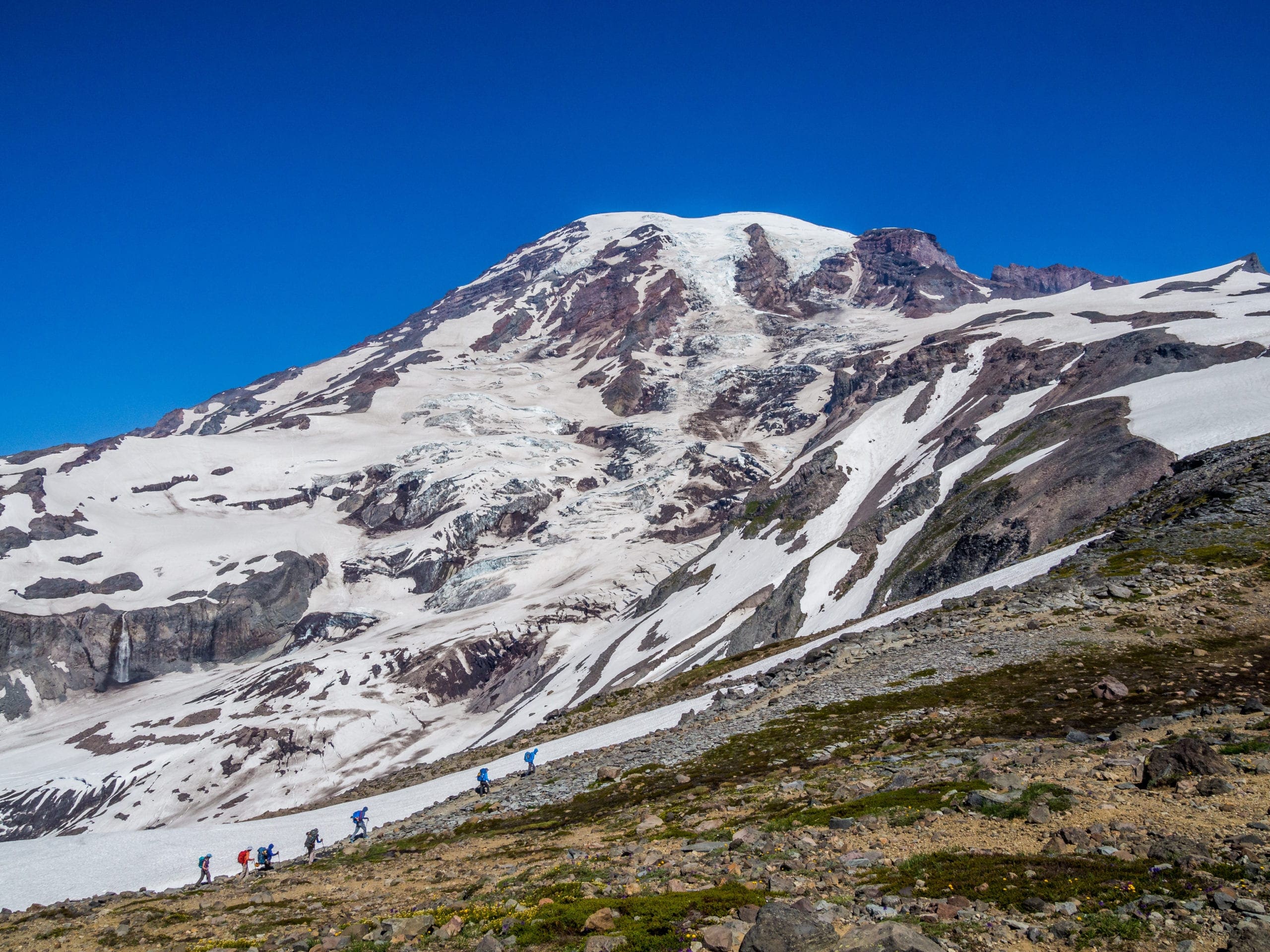
Hikers on the way to Camp Muir in Mount Rainier National Park, Washington.
Fishing:
Fishing in Mount Rainier National Park is a popular activity for many visitors who enjoy the scenic views and the variety of fish species. However, there are some rules and regulations that you need to follow to protect the native fish and the aquatic ecosystems. Here are some of the main points:
- You don’t need a state fishing license, but you need a Washington State catch record card for salmon and steelhead.
- You can fish in most lakes and streams, except for some closed waters that are listed in the Mount Rainier National Park Fish Regulations pamphlet.
- You can only keep non-native kokanee and brook trout, and you must release all native fish species.
- You can only use artificial lures and flies in streams, and you cannot use any live or dead bait fish, amphibians, eggs, or roe.
- You must use single-point barbless hooks in streams, and you cannot use lead fishing tackle.
- You can fish from one hour before sunrise to one hour after sunset, and you cannot fish from a motor road bridge.
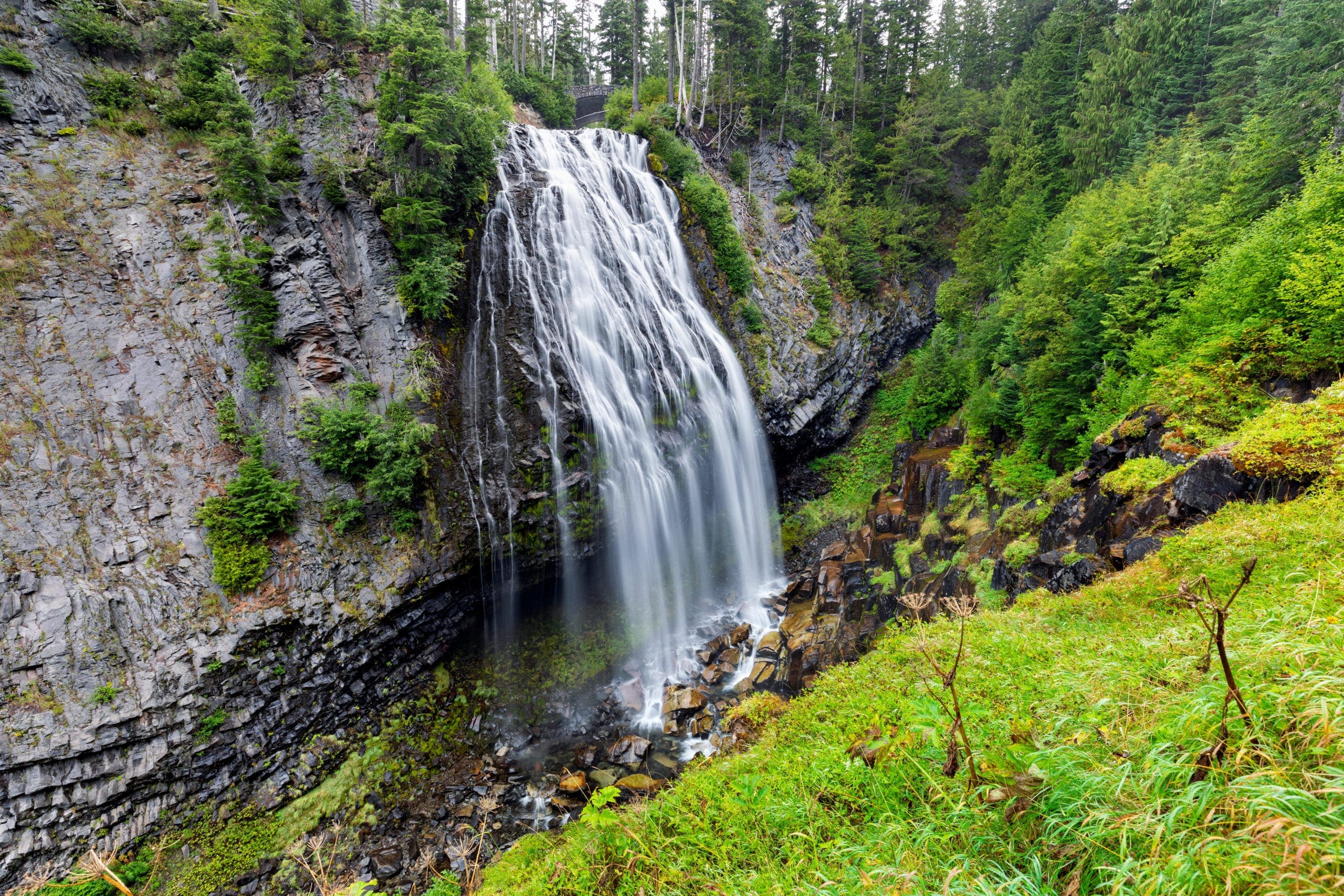
Long exposure shot of Narada Falls in Mount Rainier National Park, Washington.
Snowshoe:
While most visitors come to the park during the summer months, the park offers a variety of activities throughout the year. Snowshoeing can be found throughout the park with popular routes being Deer Lake, Narada Falls, and Sun Top.
Skiing and Snowboarding:
Both Crystal Mountain Ski Resort and White Pass Ski Area are located near Mount Rainier National Park. However, there are no designated ski areas within the park boundaries or on the mountain. Cross-country skiing, along with backcountry skiing and snowboarding can be accessed within the park for those who are equipped.
Treat Yourself To A Guided Adventure
If you’re looking to explore a new activity or deepen your mastery of an existing sport, it pays to invest in a professional. Guides not only ensure your safety when doing something for the first time, but they can also lead you off the beaten path and offer enlightening details about history, culture and geology. Plus, prepare yourself for captivating narratives no one else can tell. To hire an experienced local pro, you can use services such as 57Hours or REI Adventures.
Nearby Cities
Located along the Puget Sound, both Tacoma and Seattle are under an hour and forty-five minutes from Mount Rainier National Park. While a day trip from the big cities is possible, there are also numerous small towns that surround the mountain. Enumclaw and Eatonville sit at opposite ends of the park, both about 40 minutes from their respective park entrances. Though not established towns, Ashford and Greenwater offer a final stop of civilization before visitors enter into the park.
A trip to Washington state wouldn’t be complete without a trip to the gorgeous Mount Rainier National Park. As a symbol of state, the mountain alone draws people in to marvel at its rugged yet beautiful landscape. Whether visitors are looking for a short hike to a viewpoint, or attempting to reach the summit, Mount Rainier will be a park one won’t soon forget.
When a travel emergency arises, traditional travel insurance may not come to your aid, and a medical evacuation can cost up to $300,000.
The cost when you have a Global Rescue membership? $0. That’s why when the unexpected happens, you want the leader in rescue, evacuation and medical advisory behind you. You want Global Rescue.












